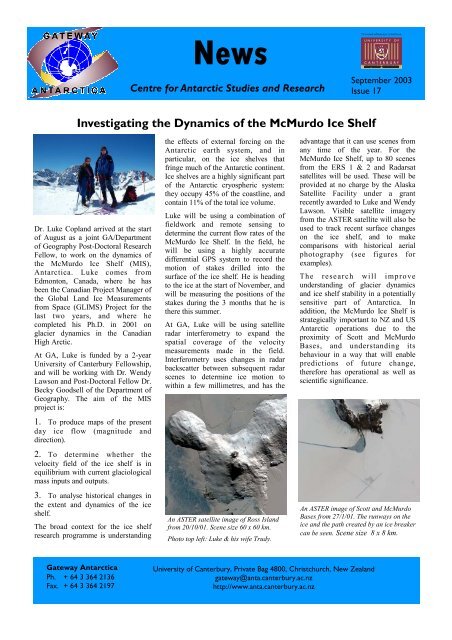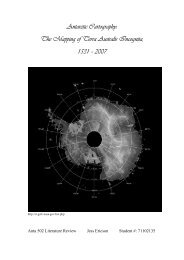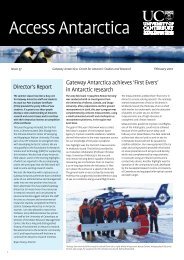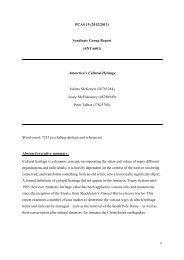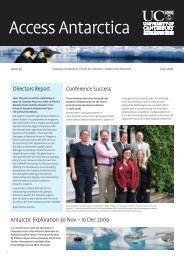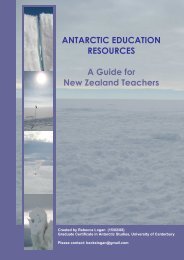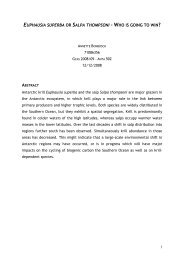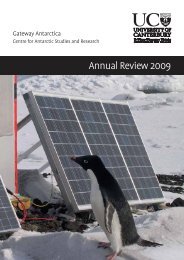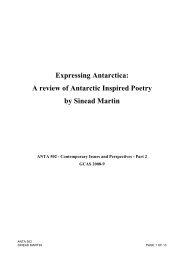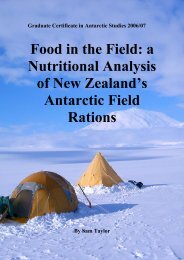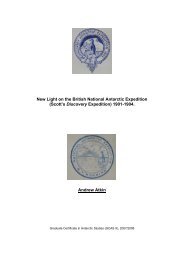September - Gateway Antarctica - University of Canterbury
September - Gateway Antarctica - University of Canterbury
September - Gateway Antarctica - University of Canterbury
Create successful ePaper yourself
Turn your PDF publications into a flip-book with our unique Google optimized e-Paper software.
NewsCentre for Antarctic Studies and Research<strong>September</strong> 2003Issue 17Investigating the Dynamics <strong>of</strong> the McMurdo Ice ShelfDr. Luke Copland arrived at the start<strong>of</strong> August as a joint GA/Department<strong>of</strong> Geography Post-Doctoral ResearchFellow, to work on the dynamics <strong>of</strong>the McMurdo Ice Shelf (MIS),<strong>Antarctica</strong>. Luke comes fromEdmonton, Canada, where he hasbeen the Canadian Project Manager <strong>of</strong>the Global Land Ice Measurementsfrom Space (GLIMS) Project for thelast two years, and where hecompleted his Ph.D. in 2001 onglacier dynamics in the CanadianHigh Arctic.At GA, Luke is funded by a 2-year<strong>University</strong> <strong>of</strong> <strong>Canterbury</strong> Fellowship,and will be working with Dr. WendyLawson and Post-Doctoral Fellow Dr.Becky Goodsell <strong>of</strong> the Department <strong>of</strong>Geography. The aim <strong>of</strong> the MISproject is:1. To produce maps <strong>of</strong> the presentday ice flow (magnitude anddirection).2. To determine whether thevelocity field <strong>of</strong> the ice shelf is inequilibrium with current glaciologicalmass inputs and outputs.3. To analyse historical changes inthe extent and dynamics <strong>of</strong> the iceshelf.The broad context for the ice shelfresearch programme is understandingthe effects <strong>of</strong> external forcing on theAntarctic earth system, and inparticular, on the ice shelves thatfringe much <strong>of</strong> the Antarctic continent.Ice shelves are a highly significant part<strong>of</strong> the Antarctic cryospheric system:they occupy 45% <strong>of</strong> the coastline, andcontain 11% <strong>of</strong> the total ice volume.Luke will be using a combination <strong>of</strong>fieldwork and remote sensing todetermine the current flow rates <strong>of</strong> theMcMurdo Ice Shelf. In the field, hewill be using a highly accuratedifferential GPS system to record themotion <strong>of</strong> stakes drilled into thesurface <strong>of</strong> the ice shelf. He is headingto the ice at the start <strong>of</strong> November, andwill be measuring the positions <strong>of</strong> thestakes during the 3 months that he isthere this summer.At GA, Luke will be using satelliteradar interferometry to expand thespatial coverage <strong>of</strong> the velocitymeasurements made in the field.Interferometry uses changes in radarbackscatter between subsequent radarscenes to determine ice motion towithin a few millimetres, and has theAn ASTER satellite image <strong>of</strong> Ross Islandfrom 20/10/01. Scene size 60 x 60 km.Photo top left: Luke & his wife Trudy.advantage that it can use scenes fromany time <strong>of</strong> the year. For theMcMurdo Ice Shelf, up to 80 scenesfrom the ERS 1 & 2 and Radarsatsatellites will be used. These will beprovided at no charge by the AlaskaSatellite Facility under a grantrecently awarded to Luke and WendyLawson. Visible satellite imageryfrom the ASTER satellite will also beused to track recent surface changeson the ice shelf, and to makecomparisons with historical aerialphotography (see figures forexamples).The research will improveunderstanding <strong>of</strong> glacier dynamicsand ice shelf stability in a potentiallysensitive part <strong>of</strong> <strong>Antarctica</strong>. Inaddition, the McMurdo Ice Shelf isstrategically important to NZ and USAntarctic operations due to theproximity <strong>of</strong> Scott and McMurdoBases, and understanding itsbehaviour in a way that will enablepredictions <strong>of</strong> future change,therefore has operational as well asscientific significance.An ASTER image <strong>of</strong> Scott and McMurdoBases from 27/1/01. The runways on theice and the path created by an ice breakercan be seen. Scene size 8 x 8 km.<strong>Gateway</strong> <strong>Antarctica</strong>Ph. + 64 3 364 2136Fax. + 64 3 364 2197<strong>University</strong> <strong>of</strong> <strong>Canterbury</strong>, Private Bag 4800, Christchurch, New Zealandgateway@anta.canterbury.ac.nzhttp://www.anta.canterbury.ac.nz
News in Brief<strong>University</strong> <strong>of</strong> <strong>Canterbury</strong> InternalGrants RoundCongratulations to the three Antarcticresearch projects which were fundedduring the recent highly competitiveinternal grants round:Neutrino detection in Antarctic ice,Jenni Adams, Physics and AstronomyDepartment, $35 000.Ice shelf sensitivity and response,Wendy Lawson and RachelSpronken-Smith, Department <strong>of</strong>Geography, $42 000.Paleozoic tectonics <strong>of</strong> the Gondwanamargin, John Bradshaw, Kari Bassett,Steve Weaver and Trevor Ireland,Department <strong>of</strong> Geological Sciences,$28 000.Graduate Certificate in AntarcticStudiesThe GCAS course again provedpopular this year with 32 applicantscompeting for the 20 coursepositions. Applicants came from sixdifferent countries including USA,UK, Germany, Canada and Australia.Twenty students have accepted placeson the course which will commenceon Monday 10 November.UNEP GRID-C was pleased to hostand meet with Dr. Keith Finlayson.Keith became the Polar Manager atUNEP GRID-Arendal in February2003. Keith is a physicist who hasworked in the Antarctic with theAustralian Antarctic Division and isvery familiar with both Polar Regions.Discussions at the <strong>Gateway</strong><strong>Antarctica</strong> meeting were focusedprimarily on strengthening linksbetween GRID-Arendal and GRID-Christchurch. There was alsodiscussion concerning the GlobalEnvironment Facility and closer tieswith the <strong>University</strong> <strong>of</strong> the Arctic.Update on Winter Science by Rebecca Batchelor(Rebecca is a PhD candidate from the UC Department <strong>of</strong> Physics & Astronomy)Winter is drawing to a close. Formost <strong>of</strong> you that means days aregetting a little longer, maybe its stilllight when you go home from the<strong>of</strong>fice. Down here in <strong>Antarctica</strong>, it’s arapid change between total night-timeand total day, a change from a quiet,relaxed group <strong>of</strong> 15 to the hecticsummer season with people comingand going and base numbers gettingup towards a hundred. And for me,it’s the time to return to New Zealandafter nearly 10 <strong>of</strong> the most wonderfulmonths <strong>of</strong> my life on the ice.Wintering-over in <strong>Antarctica</strong> isspecial – I don’t think anyone who’sdone it would disagree. The teamaround you are your family, for betteror worse, and if you don’t get on, toobad – once that plane leaves you’restuck here. Fortunately for me, Icouldn’t have asked for a better groupto be here with. This winter was a bitdifferent from normal, with threescience students doing researchprojects over the winter - myself, andtwo sea-ice scientists from Otago<strong>University</strong>. A bit <strong>of</strong> an experiment for<strong>Antarctica</strong> New Zealand, but onethat’s been a resounding success andwill hopefully continue into thefuture. My project aimed to measurestratospheric trace gases using the fullmoon as a light source, in an attemptto better understand thepreconditioning that leads to ozoneloss in Spring. In theory I could takemeasurements for a little over a weekaround each full moon. After a month<strong>of</strong> two <strong>of</strong> storms and terrible weatherconditions however, I wasconsidering changing my thesis to"The Effect <strong>of</strong> the Full Moon on RossIsland Weather." Still, with goodluck and determination, I was able totake at least some readings eachmonth and gather the data I neededfor my thesis. Another great thing Iwas involved with was launchinghelium filled balloons with ozonedetectors on them as part <strong>of</strong> aninternational project to betterunderstand ozone depletion. Alongwith 10 other stations in <strong>Antarctica</strong>,McMurdo was launchingapproximately 3-4 balloons per weekfrom June through until October. One<strong>of</strong> the American science techs and Iran the McMurdo campaign for the<strong>University</strong> <strong>of</strong> Wyoming through thewinter, launching balloons ondemand, day or night 7 days a week. Itwas a great project – getting outsideand getting the chance to work veryclosely with people from McMurdo.On top <strong>of</strong> that, the experiment hasprovided me with some excellent datato use in my own research.But winter is not all about work.There’s a close tie between Scott Baseand McMurdo Station (population thiswinter: 198), and you can get involvedin bowling, darts, cards or volleyballleagues, join (or listen to) a band, goto parties, wine tastings or just hangout. The kiwi A-frame was a popularhide-away destination, and there’splenty <strong>of</strong> time to get out for a walk ora ski. Highlights for me includedwalks under a flaming aurora-lit sky,camping out in an igloo, and joiningthe sea-ice team on one <strong>of</strong> their 48-hour measurement trips and having aseal come up through a dive hole. Thegreat experiences are too numerous tomention.But now, I’m due to leave here in lessthan a week. I’m looking forward tograss and trees and rain and fruit andwalking on the beach, but it’s tingedwith sadness at leaving behind thistime – the people, the experiences,and especially the place. <strong>Antarctica</strong>, Ithink it’s an addiction.RebeccaBatchelorlaunching ozonedetectors fromhelium – filledballoons in<strong>Antarctica</strong>.<strong>Gateway</strong> <strong>Antarctica</strong>Ph. + 64 3 364 2136Fax. + 64 3 364 2197<strong>University</strong> <strong>of</strong> <strong>Canterbury</strong>, Private Bag 4800, Christchurch, New Zealandgateway@anta.canterbury.ac.nzhttp://www.anta.canterbury.ac.nz


